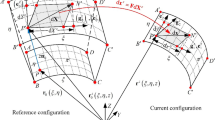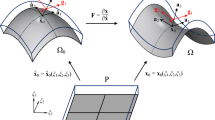Summary
The objective of this contribution is to model large inelastic strains of ductile metals, to couple this material model with a multilayer shell kinematics and finally to achieve a finite element formulation applicable in general form to shell analysis. Elasto-plastic constitutive law is formulated by using the multiplicative decomposition of the deformation gradient and Neo-Hookean model for elastic strains assuming an overall isotropic material behavior. These 3D-material model is then enforced directly into a multilayer shell kinematics which provides a very accurate consideration of local effects, particularly stresses across the thickness. Finite element formulation is accomplished by means of the enhanced strain concept. Thus the well known deficiencies due to incompressible deformations and the inclusion of transverse strains are avoided. Several examples are given to demonstrate the performance of the algorithms developed concerning various aspects.
Similar content being viewed by others
References
Simo, J. C.: A framework for finite strain elastoplasticity based on maximum plastic dissipation and the multiplicative decomposition: Part I: Continuum formulation. Comp. Meth. Appl. Mech. Eng.66, 199–219 (1988).
Simo, J. C.: A framework for finite strain elastoplasticity based on maximum plastic dissipation and the multiplicative decomposition: Part II: Computational aspects. Comp. Meth. Appl. Mech. Eng.68, 1–31 (1988).
Cuitiño, A., Ortiz, M.: A material-independent method for extending stress update algorithms from small strain plasticity to finite with multiplicative kinematics. Eng. Comp.9, 437–451 (1992).
Moran, B., Ortiz, M., Shih, C. F.: Formulation of implicit finite element methods for multiplicative finite deformation plasticity. Int. J. Num. Meth. Eng.29, 483–514 (1990).
Eterović, A. L., Bathe, K.-J.: A hyperelastic-based large strain elasto-plastic constitutive formulation with combined isotropic-kinematic hardening using the logarithmic stress and strain measures. Int. J. Num. Meth. Eng.30, 1099–1114 (1990).
Weber, G., Anand, L.: Finite deformation constitutive equations and a time integration procedure for isotropic hyperelastic-viscoplastic solids. Comp. Meth. Appl. Mech. Eng.79, 173–202 (1990).
Perić, D., Owen, D. J. R., Honnor, M. E.: A model for finite strain elasto-plasticity based on logarithmic strains: Computational issues. Comp. Meth. Appl. Mech. Eng.94, 35–61 (1992).
Simo, J. C., Miehe, C.: Associative coupled thermoplasticity at finite strains: Formulation, numerical analysis and implementation. Comp. Meth. Appl. Mech. Eng.94, 41–104 (1992).
Simo, J. C.: Algorithms for static and dynamic multiplicative plasticity that preserve the classical return mapping schemes of the infinitesimal theory. Comp. Meth. Appl. Eng.99, 61–112 (1992).
Atluri, S. N.: On constitutive relations at finite strain: Hypo-elasticity and elasto-plasticity with isotropic or kinematic hardening. Comp. Meth. Appl. Mech. Eng.43, 137–171 (1984).
Needleman, A.: On finite element formulations for large elastic-plastic deformations. Comp. & Struct.20, 247–257 (1985).
Müller-Hoeppe, N.: Beiträge zur Theorie und Numerik finiter inelastischer Deformationen. PhD-Thesis, Forschungs- und Seminarbericht aus dem Bereich der Mechanik der Universität Hannover Nr. F 90/4, 1990.
Hackenberg, H.-P.: Über die Anwendung inelastischer Stoffgesetze auf finite Deformationen mit der Methode der Finiten Elemente. PhD-Thesis, TH Darmstadt, Nr. D 17, 1992.
Başar, Y., Eckstein, A.: Large inelastic strain analysis by multi-layer kinematics. In: Aspects in modern computational structural analysis (Meskouris, K., Wittek, U., eds.), pp. 121–136, Balkema Publishers, Rotterdam 1997.
Schieck, B., Stumpf, H.: Deformation analysis for finite elastic-plastic strains in a Lagrangean-type description. Int. J. Sol. Struct.30 (19), 2639–2660 (1993).
Schieck, B., Stumpf, H.: The appropriate corotional rate, exact formula for the plastic spin and costitutive model for finite elastoplasticity. Int. J. Sol. Struct.32 (24), 3643–3667 (1995).
Epstein, M., Glockner, P. G.: Nonlinear analysis of multilayered shells. Int. J. Sol. Struct.13, 1081–1089 (1977).
Reddy, J. N.: On refined computational models of composite laminates. Int. J. Num. Meth. Eng.27, 361–382 (1989).
Noor, A. K., Burton, W. S., Peters, J. M.: Assessment of computational models for multilayered composite cylinders. Int. J. Sol. Struct.27, 1269–1286 (1991).
Başar, Y.: Finite-rotation theories for arbitrary composite laminates, Acta Mech.98, 159–176 (1993).
Başar, Y., Ding, Y.: Interlaminar stress analysis of composites: Layer-wise shell finite elements including transverse strains. Composites Engineering5 (5), 485–499 (1995).
Braun, M., Bischoff, M., Ramm, E.: Nonlinear shell formulations for complete three-dimensional constitutive laws including composites and laminates. Comp. Mech.15, 1–18 (1994).
Wagner, W., Gruttmann, F.: A simple finite rotation formulation for composite shell elements. Eng. Comp.11, 145–176 (1994).
Başar, Y., Hanskötter, U., Ding, Y.: Finite element simulation of stress concentrations. In: Advances in computational engineering science (Alturi, S. N., Yagana, G., eds.), pp. 1232–1237, Int. Conf. on Computational Engineering Science 1997. San Jose, Costa Rica, 1997.
Büchter, N., Ramm, E., Roehl, D.: Three-dimensional extension of nonlinear shell formulation based on the enhanced assumed strain concept. Int. J. Num. Meth. Eng.37, 2551–2568 (1994).
Betsch, P., Stein, E.: An assumed strain approach avoiding artifical thickness straining for a nonlinear 4-node shell element. Comm. Num. Meth. Eng.11, 899–909 (1995).
Parisch, H.: A continuum-based shell theory for nonlinear applications. Int. J. Num. Meth. Eng.38, 1855–1883 (1993).
Verhoeven, H.: Geometrisch und physikalisch nichtlineare finite Plattenelemente mit Berücksichtigung der Dickenverzerrung. PhD-Thesis, Technische Universität Berlin, Verlag Shaker, Aachen, 1993.
Sansour, C.: A theory and finite element formulation of shells at finite formulations involving thickness change: Circumventing the use of a rotation tensor. Arch. Appl. Mech.65, 194–216 (1995).
Simo, J. C., Rifai, S.: A class of mixed assumed strain methods and the method of incompatible modes. Int. J. Num. Meth. Eng.29, 1595–1638 (1990).
Betsch, P., Gruttmann, F., Stein, E.: A 4-node finite shell element for the implementation of general hyperelastic 3D-elasticity at finite strains. Comp. Meth. Appl. Mech. Eng.130, 57–79 (1996).
Bischoff, M., Ramm, E.: Shear deformable shell elements for large strains and deformations. Int. J. Num. Meth. Eng.40, 4427–4449 (1997).
Seifert, B.: Zur Theorie und Numerik finiter elastoplastischer Deformationen von Schalenstrukturen. PhD-Thesis, Forschungs- und Seminarberichte aus dem Bereich der Mechanik der Universität Hannover Nr. F 96/2, 1996.
Miehe, C.: A theoretical and computational model for isotropic elasto-plastic stress analysis in shells at large strains. Comp. Meth. Appl. Mech.155, 193–233 (1998).
Kollmann, F. G., Sansour, C.: Viscoplastic Shells — Theory and numerical analysis. Arch. Mech.49, 477–511 (1997).
Wriggers, P., Eberlein, R., Reese, S.: A comparison of three-dimensional continuum and shell elements for finite plasticity. Int. J. Sol. Struct.33, 3309–3326 (1996).
Eberlein, R.: Finite-Elemente-Konzepte für Schalen mit großen elastischen und plastischen Verzerrungen. PhD-Thesis, TH Darmstadt, Nr. D 17, 1997.
Simo, J. C., Armero, F.: Geometrically nonlinear enhanced strain mixed methods and the method of incompatible modes. Int. J. Num. Meth. Eng.33, 1413–1449 (1992).
Stumpf, H., Schieck, B.: Theory and analysis of shells undergoing finite elasto-plastic strains and rotations. Acta Mech.106, 1–21 (1994).
Dvorkin, E. N., Pantuso, P., Repetto, E. D.: A fromulation of the MITC4 shell element for finite strain elasto-plastic analysis. Comp. Meth. Appl. Mech. Eng.125, 17–40 (1995).
Roehl, D. de M., Ramm, E.: Large elasto-plastic finite element analysis of solids and shells with the enhanced assumed strain concept. Int. J. Sol. Struct.33, 3215–3237 (1996).
Lee, E. H.: Elasto-plastic deformation at finite strains, J. Appl. Mech.36, 1–6 (1969).
Hackenberg, H.-P., Kollmann, F. G.: A general theory of finite inelastic deformation of metals based on the concept of unified constitutive models. Acta Mech.110, 217–239 (1995).
Simo, J. C., Fox, D. D.: On a stress resultant geometrically exact shell model. Part I: Formulation and optimal parametrization. Comp. Meth. Appl. Mech. Eng.72, 267–304 (1989).
Menzel, W.: Gemischt-hybride Elementformulierungen für komplexe Schalenstrukturen unter endlichen Rotationen. PhD-Thesis, Technisch-wissenschaftliche Mitteilung Nr. 96-4, Institut für konstruktiven Ingenieurbau, Ruhr-Universität Bochum, 1996.
Celigoj, C. C.: A strain-and-displacement-based variational method applied to geometrically nonlinear shells. Int. J. Num. Meth. Eng.39 (13), 2231–2248 (1996).
Wriggers, P., Reese, S.: A note on enhaced strain methods for large deformations. Comp. Meth. Appl. Mech. Eng.135, 201–209 (1996).
Dvorkin, E. N., Bathe, K.-J.: A continuum mechanics based four-node shell element for general nonlinear analysis. Eng. Comput.1, 77–88 (1994).
Szabó, I.: Höhere Technische Mechanik, 4th ed. Berlin, Springer 1964.
Başar, Y., Ding, Y.: Finite element analysis of hyperelastic thin shells with large strains. Comput. Mech.18, 200–214 (1996).
Author information
Authors and Affiliations
Rights and permissions
About this article
Cite this article
Başar, Y., Eckstein, A. Large inelastic strain analysis by multilayer shell elements. Acta Mechanica 141, 225–252 (2000). https://doi.org/10.1007/BF01268679
Received:
Revised:
Issue Date:
DOI: https://doi.org/10.1007/BF01268679




